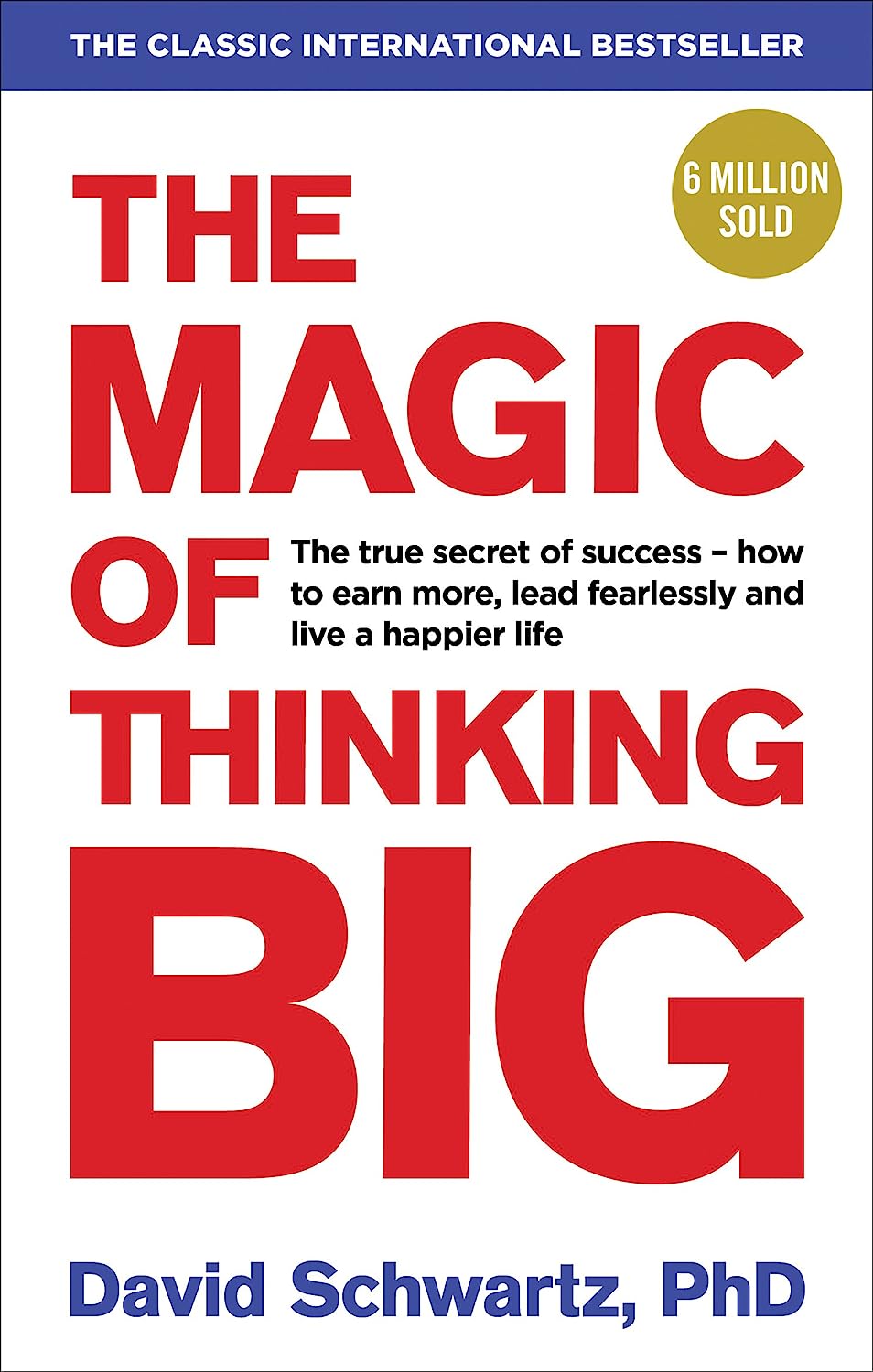Belief in Oneself
In the bustling journey through David J. Schwartz's "The Magic of Thinking Big," there's a radiant gem of wisdom that shines particularly bright: the theme of "Belief in Oneself." This theme doesn't just whisper; it sings the truth about the monumental power of self-confidence in our lives.
Schwartz boldly asserts, "Believe you can succeed and you will." This simple yet profound statement captures the essence of the book's stance on self-belief. It's not about harboring a vague hope that things might work out; it's about cultivating a robust and unwavering faith in one's capabilities. Schwartz doesn’t just suggest this; he presents it as a fundamental law of personal achievement.
But how does one foster this belief? Schwartz provides actionable insights. He encourages us to dismiss the self-defeating myths that often plague our minds. These myths, like 'I don’t have enough talent,' or 'I’m not smart enough,' are barriers we construct ourselves. Schwartz's wisdom shines through as he dismantles these myths, revealing them as mere shadows that dissipate under the light of self-belief.
One of the book's most compelling points is the connection between self-belief and action. Schwartz eloquently states, "Action cures fear." This is pivotal. He’s not just asking us to feel confident but to act on it. When we move, when we tackle tasks, when we step out of our comfort zones, we're not just doing; we're affirming our belief in ourselves.
Moreover, Schwartz illuminates how self-belief isn't a solo journey. It's about how we see ourselves and how we let others influence that view. He reminds us, "Others see in us what we see in ourselves." This is a call to reflect positivity and capability, not just for ourselves, but to inspire the same in others.
In sum, "Belief in Oneself" in "The Magic of Thinking Big" isn’t just a theme; it’s a call to action, a philosophy for living. It’s about dismantling doubts, embracing potential, and understanding that the foundation of success lies within our perception of ourselves. Schwartz's message is clear: believe in yourself, and the world opens up to you.
As you turn each page, this theme acts like a beacon, guiding you towards not just understanding the importance of self-belief, but living it. This is not just a read; it’s an awakening to the power that resides in every one of us – the power that starts with believing in oneself.
Setting High Goals
"The Magic of Thinking Big" radiates an empowering message, especially through its theme of Setting High Goals. David J. Schwartz doesn’t just advise us to set goals; he urges us to reach for the stars. It's about aiming not just for what we think we can achieve, but for what we dream of achieving.
Schwartz firmly believes that the size of our success is directly proportional to the size of our goals. “Think little goals and expect little achievements. Think big goals and win big success,” he writes. This powerful statement encapsulates the essence of setting high goals. It's not just about ambition; it's about expanding the horizons of what we believe is possible.
In every chapter, Schwartz champions the belief that we limit ourselves with our own thinking. He argues that when we set higher goals, we inherently elevate our mindset, work ethic, and determination. By doing so, we not only aim higher but also enhance our capacity to achieve these goals.
A particularly striking aspect of this theme is the emphasis on not letting the environment dictate our goals. “Do not let traditions and customs, the way it's always been done, the beliefs of other people limit your own belief in yourself,” Schwartz advises. This idea is a clarion call to break free from the shackles of conventional thinking and societal norms that often stifle our true potential.
The book illustrates this with inspiring examples of individuals who dared to think big and set lofty goals. These stories serve as a testament to the limitless possibilities that unfold when we dare to dream big.
Overcoming Fear: A Journey to Confidence and Success
In "The Magic of Thinking Big," David J. Schwartz presents 'Overcoming Fear' as a pivotal stepping stone towards achieving greatness. This theme resonates through the book, serving as a clarion call to break free from the shackles of self-doubt and anxiety that often hold us back from realizing our full potential.
Schwartz delves into the psychology of fear, explaining that it's not just an emotion, but a barrier that prevents individuals from taking action. He asserts, "Action cures fear. Indecision, postponement, on the other hand, fertilize fear." This powerful statement encapsulates the essence of the theme – fear loses its grip when we decisively move towards our goals.
The author emphasizes the need to confront fear head-on. He doesn't just leave the reader with the problem but offers practical solutions. For instance, he encourages the reader to dissect their fears, understand their root causes, and then face them with a plan of action. This approach transforms fear from a formidable enemy into a manageable obstacle.
A significant part of this theme revolves around reprogramming one's mindset. Schwartz persuades the reader to shift their focus from fear to success. He states, "Deposit only positive thoughts in your memory bank." This idea isn't just poetic; it's a strategy. By filling our minds with positive, success-oriented thoughts, we naturally begin to edge out the negative fears that once seemed overwhelming.
Moreover, Schwartz highlights the importance of not magnifying problems. He wisely notes, "How big we think, determines the size of our accomplishments." Often, fear is a product of overestimating difficulties and underestimating our own capabilities to overcome them.
Positive Thinking: Unlocking Your Potential with Optimism
Dive into the vibrant theme of Positive Thinking in David J. Schwartz's "The Magic of Thinking Big," a theme that stands as a beacon, illuminating the path to personal and professional triumph. Positive thinking isn't just an abstract concept in this book; it's a practical, powerful tool that Schwartz masterfully presents as the engine driving all success.
Schwartz declares, “Believe you can succeed and you will.” This simple yet profound statement is the cornerstone of the book's approach to Positive Thinking. It's not just about fostering a feel-good mentality; it's about cultivating a mindset that sees possibilities where others see barriers.
The author examines the structure of the optimistic mind and demonstrates how having a positive outlook frees you from the paralyzing fear of failure to approach problems with a solution-focused mindset. Schwartz emphasizes, “The mind is what the mind is fed,” driving home the point that feeding your mind with positive thoughts leads to positive outcomes.
Schwartz doesn't just leave you with concepts; he provides actionable strategies. For instance, he suggests replacing negative thoughts with positive ones and encourages the reader to practice this daily. This act, seemingly simple, is a transformative exercise in reprogramming the mind to focus on growth, potential, and success.
Moreover, Schwartz highlights the contagious nature of positivity. By maintaining a positive attitude, you not only set yourself up for success but also influence those around you. This ripple effect can create an environment of optimism and possibility, both in personal and professional spaces.
Taking Action: The Stepping Stone to Triumph
In the invigorating pages of "The Magic of Thinking Big," David J. Schwartz instills a simple yet profound truth: action is the golden key to success. This theme resonates with vibrant energy throughout the book, underscoring the idea that dreams and goals, no matter how grand, are merely castles in the air without the solid foundation of action.
Schwartz eloquently states, "Ideas are worthless unless we act on them." This powerful statement is the cornerstone of the "Taking Action" theme. He drives home the point that thinking big is not just about ambitious dreams and grandiose visions. It's about the small, consistent steps we take towards turning these dreams into reality. The magic truly happens when thought and action align.
The book is peppered with stimulating anecdotes and real-life examples that illustrate how taking decisive action, irrespective of fear or doubt, paves the way for extraordinary achievements. Schwartz emphasizes that action doesn't always mean monumental steps; even the smallest actions, when taken in the right direction, can lead to great results. It's about overcoming the inertia of procrastination and the paralysis of over-analysis. As Schwartz puts it, "Action cures fear. Indecision, postponement, on the other hand, fertilize fear."
The author challenges the reader to move beyond mere wishful thinking. He encourages embracing a 'do it now' attitude. This theme isn’t just about taking action; it's about taking intelligent, focused action. Schwartz advises, "Think little goals and expect little achievements. Think big goals and win big success." The message is clear: the size of your actions reflects the size of your results.
Building Relationships: The Cornerstone of Success
David J. Schwartz's "The Magic of Thinking Big" offers a treasure trove of wisdom, but one of its most radiant gems is the theme of 'Building Relationships'. Schwartz artfully delves into how our interactions with others can significantly propel us toward our goals. In a world brimming with ambitions, it's the bonds we forge that often become our stepping stones to success.
"Success depends on the support of other people," Schwartz writes, instantly grounding us in the reality that our dreams and goals aren't solitary endeavors. This theme is a clarion call to acknowledge the power of collaborative efforts and mutual support. It's not just about networking in the traditional sense; it's about nurturing genuine connections that provide mutual growth and understanding.
Schwartz emphasizes the importance of viewing others not as stepping stones, but as partners in the journey to achievement. He advocates for a mindset that values empathy, understanding, and respect in all interactions. "The ability to get along with and influence people is a skill that can be developed," he notes, reminding us that building strong relationships is a skill akin to learning a new language or mastering a musical instrument.
This theme also underscores the importance of effective communication. Schwartz provides actionable advice on how to communicate more effectively, such as listening with intent, showing genuine interest in others’ perspectives, and expressing ideas clearly and confidently. Through these strategies, he demonstrates how strong relationships are built on the bedrock of mutual respect and understanding.

